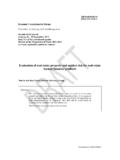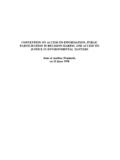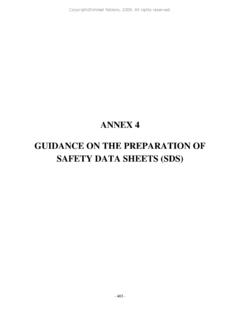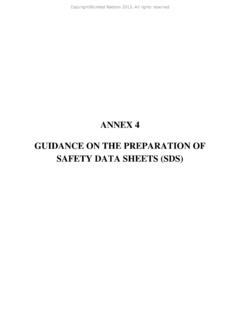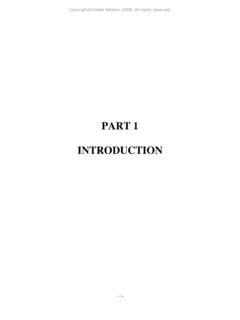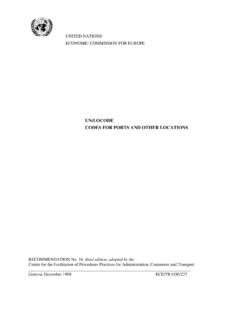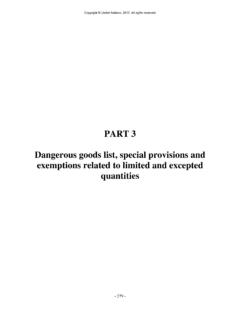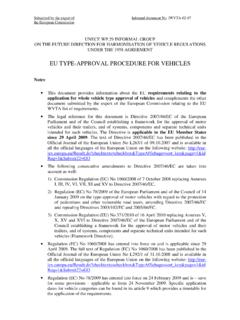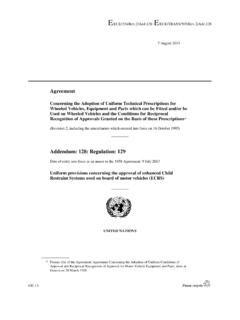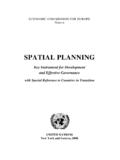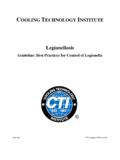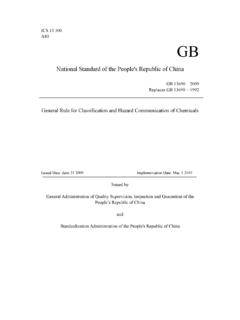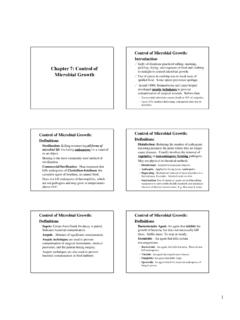Transcription of PART 3 DANGEROUS GOODS LIST AND LIMITED …
1 - 171 - PART 3 DANGEROUS GOODS LIST AND LIMITED QUANTITIES EXCEPTIONS - 173 - CHAPTER GENERAL Scope and general provisions The DANGEROUS GOODS List in this Chapter lists the DANGEROUS GOODS most commonly carried but is not exhaustive. It is intended that the list cover, as far as practicable, all DANGEROUS substances of commercial importance. Where a substance or article is specifically listed by name in the DANGEROUS GOODS List, it shall be transported in accordance with the provisions in the List which are appropriate for that substance or article. A generic or not otherwise specified entry may be used to permit the transport of substances or articles which do not appear specifically by name in the DANGEROUS GOODS List.
2 Such a substance or article may be transported only after its DANGEROUS properties have been determined. The substance or article shall then be classified according to the class definitions and test criteria and the name in the DANGEROUS GOODS List which most appropriately describes the substance or article shall be used. The classification shall be made by the appropriate competent authority when so required or may otherwise be made by the consignor. Once the class of the substance or article has been so established, all conditions for dispatch and transport, as provided in these Regulations shall be met. Any substance or article having or suspected of having explosive characteristics shall first be considered for inclusion in Class 1. Some collective entries may be of the generic or not otherwise specified type provided that the regulations contain provisions ensuring safety, both by excluding extremely DANGEROUS GOODS from normal transport and by covering all subsidiary risks inherent in some GOODS .
3 The DANGEROUS GOODS List does not include GOODS which are so DANGEROUS that their transport, except with special authorization, is prohibited. Such GOODS are not listed because the transport of some GOODS may be prohibited for some modes of transport and allowed in others and, in addition, because it would be impossible to draw up an exhaustive list. Moreover, any such list would soon cease to be exhaustive because of the frequent introduction of new substances; and the absence of a substance from such a list might give the mistaken impression that that substance could be carried without special restrictions. Inherent instability in GOODS may take different DANGEROUS forms, for example, explosion, polymerization, with intense evolution of heat, or emission of toxic gases.
4 In respect of most substances, such tendencies can be controlled by correct packing, dilution, stabilization, addition of an inhibitor, refrigeration or other precautions. Where precautionary measures are laid down in the DANGEROUS GOODS List in respect of a given substance or article ( that it shall be stabilized or with x% water or phlegmatizer ) such substance or article may not normally be carried when these measures have not been taken, unless the item in question is listed elsewhere ( Class 1) without any indication of, or with different, precautionary measures. Proper shipping name NOTE 1: For proper shipping names to be used for DANGEROUS GOODS transported as LIMITED quantities, see NOTE 2: For proper shipping names used for the transport of samples, see The proper shipping name is that portion of the entry most accurately describing the GOODS in the DANGEROUS GOODS List, which is shown in upper case characters (plus any numbers, Greek letters, sec , tert , and the letters m, n, o, p, which form an integral part of the name).
5 An alternative proper shipping name may be shown in brackets following the main proper shipping name [ , ETHANOL (ETHYL ALCOHOL)]. Portions of an entry appearing in lower case need not be considered as part of the proper shipping name but may be used. - 174 - When conjunctions such as and or or are in lower case or when segments of the name are punctuated by commas, the entire name of the entry need not necessarily be shown in the transport document or package markings. This is the case particularly when a combination of several distinct entries are listed under a single UN Number. Examples illustrating the selection of the proper shipping name for such entries are: (a) UN 1057 LIGHTERS or LIGHTER REFILLS - The proper shipping name is the most appropriate of the following possible combinations: LIGHTERS LIGHTER REFILLS; (b) UN 2793 FERROUS METAL BORINGS, SHAVINGS, TURNINGS or CUTTINGS in a form liable to self-heating.
6 The proper shipping name is the most appropriate of the following combinations: FERROUS METAL BORINGS FERROUS METAL SHAVINGS FERROUS METAL TURNINGS FERROUS METAL CUTTINGS each supplemented with the technical name of the GOODS (see ). Proper shipping names may be used in the singular or plural as appropriate. In addition, when qualifying words are used as part of the proper shipping name, their sequence on documentation or package markings is optional. For instance, DIMETHYLAMINE AQUEOUS SOLUTION may alternatively be shown AQUEOUS SOLUTION OF DIMETHYLAMINE . Commercial or military names for GOODS of Class 1 which contain the proper shipping name supplemented by additional descriptive text may be used. Many substances have an entry for both the liquid and solid state (see definitions for liquid and solid in ), or for the solid and solution.
7 These are allocated separate UN numbers which are not necessarily adjacent to each other. Details are provided in the alphabetical index, : NITROXYLENES, LIQUID 1665 NITROXYLENES, SOLID 3447 Unless it is already included in capital letters in the name indicated in the DANGEROUS GOODS List, the qualifying word MOLTEN shall be added as part of the proper shipping name when a substance, which is a solid in accordance with the definition in , is offered for transport in the molten state ( ALKYLPHENOL, SOLID, , MOLTEN).
8 Except for self-reactive substances and organic peroxides and unless it is already included in capital letters in the name indicated in the DANGEROUS GOODS List, the word STABILIZED shall be added as part of the proper shipping name of a substance which, without stabilization, would be forbidden from transport in accordance with due to it being liable to dangerously react under conditions normally encountered in transport ( : TOXIC LIQUID, ORGANIC, , STABILIZED ). When temperature control is used to stabilize such substances to prevent the development of any DANGEROUS excess pressure, then: (a) For liquids: where the SADT is less than or equal to 50 C, the provisions of shall apply; (b) For gases: the conditions of transport shall be approved by the competent authority.
9 - 175 - Hydrates may be transported under the proper shipping name for the anhydrous substance. Generic or not otherwise specified ( ) names Generic and not otherwise specified proper shipping names that are assigned to special provision 274 in Column 6 of the DANGEROUS GOODS List shall be supplemented with the technical or chemical group names unless a national law or international convention prohibits its disclosure if it is a controlled substance. For explosives of Class 1, the DANGEROUS GOODS description may be supplemented by additional descriptive text to indicate commercial or military names. Technical and chemical group names shall be entered in brackets immediately following the proper shipping name. An appropriate modifier, such as contains or containing or other qualifying words such as mixture , solution , etc.
10 And the percentage of the technical constituent may also be used. For example: UN 1993 Flammable liquid, (contains xylene and benzene), 3, PG II . The technical name shall be a recognized chemical or other name currently used in scientific and technical handbooks, journals and texts. Trade names shall not be used for this purpose. In the case of pesticides, only ISO common name(s), other name(s) in the World Health Organisation (WHO) Recommended Classification of Pesticides by Hazard and Guidelines to Classification, or the name(s) of the active substance(s) may be used. When a mixture of DANGEROUS GOODS is described by one of the or generic entries to which special provision 274 has been allocated in the DANGEROUS GOODS List, not more than the two constituents which most predominantly contribute to the hazard or hazards of a mixture need to be shown, excluding controlled substances when their disclosure is prohibited by national law or international convention.
